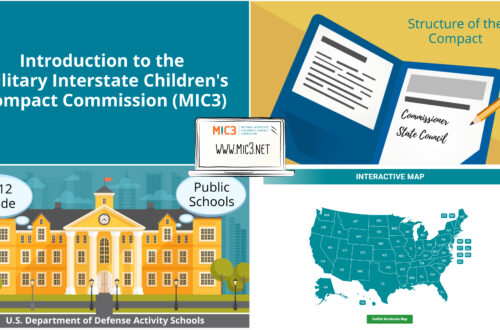
Midyear Moves: Transitions When School is in Full Swing
By Stacy Allsbrook-Huisman
Moves for military families are usually associated with spring and summer months, a natural break in the school calendar. However, almost half of military transitions are midyear moves, often during the winter holidays. No matter what time of year a military-connected student changes schools, the Seasons of TransitionTM cycle is in effect: the Season of Leaving, Season of Arriving, Season of Growing, and Season of Thriving. For a wintertime move, the anticipation that initiates the Season of Leaving may begin in August or September. This means a student could begin the school year with visions of moving trucks dancing in her head.
In a midyear move, students face challenges such as making friends in an established classroom and starting school work in midstream. When the curricula of sending and receiving schools are different—as is often the case—students may face gaps or overlaps in learning. Receiving teachers meet these challenges by adjusting lesson plans, class activities, and seating to accommodate the student’s needs. For parents, moving at midyear means that, in addition to all the tasks and stresses of a move, they must get students enrolled and on track at a new school, without the buffer of a long school break.
Preparation and planning will make any move smoother. Here are some tools and tips for creating smooth transitions when a midyear move kicks off another cycle of the Seasons of Transition:
Exit plan
Because the student’s last day of class may not coincide with a break in the school calendar, having an exit plan is especially helpful for a midyear move. The exit plan includes a checklist and timeline for all the events and tasks leading up to the student’s departure: project and test dates, deadlines for withdrawal procedures, and farewell parties or events. Making time to say goodbye to friends and teachers is important. As soon as a military family knows about a move, it’s a good time to meet with teachers to create this plan. The exit plan should take into account the student’s academic strengths and weaknesses. Perhaps the student would benefit from a packet of supplemental work or books to read during transition, if he will be out of school for more than a few days.
Education Binder
Created by parents and teachers, the Education Binder helps the receiving school integrate a new student quickly in the Season of Arriving, which is especially important in midyear moves, when classes are already in full swing. The binder supplements a student’s official transcript with detailed academic and personal information. The binder should include work samples, letters from teachers, awards, documents regarding special programs or needs, copies of report cards, and more. When parents and teachers meet to create the exit plan, they should also consider how to update the binder, adding teacher-to-teacher letters, a list of current textbooks, and samples of student’s latest work.
Withdrawal and enrollment
Preparing for a move at midyear means knowing a school’s policies on early withdrawal. Middle and high school students may risk losing credits if they are withdrawn from school before the semester ends or before crucial test dates. Departure dates may need to be adjusted if possible. Parents may also contact the receiving school—if known—to find out if there are special requirements or considerations for midyear enrollment. When the student arrives at the new school, parents introduce their student with the Education Binder. The material in the binder will inform the receiving school and teachers quickly and efficiently about the student’s history, personality, and capabilities.
Resources
Every military installation has a school liaison officer, or SLO, who can help with information about local school systems, services and programs. For midyear moves, the SLO is also a good point of contact for information about the Interstate Compact on Educational Opportunity for Military Children. The compact provides accommodations for military students at public schools. It gives schools flexibility on some policies as applied to military students, particularly those related to enrollment, graduation, and program eligibility.
The bright side
A midyear move may be a fast and furious transition, but an up-tempo transition can be a good thing. There’s less time for the student to find new connections but also less time to worry about fitting in at a new school. Also, students who arrive at a new school in midyear get a bit more attention than those who start the first day of school. This offers a new student an opportunity to shine and get a little extra attention and not be lost in a crowd of new faces.
Whenever a military move happens, a healthy Season of Leaving and Season of Arriving set the student up for success in both the Season of Growing and Season of Thriving. For midyear moves, students, parents, and teachers can work together for a good transition with planning, preparation, and a positive outlook.
Stacy Allsbrook-Huisman is an Air Force spouse, writer, mother, and military child advocate. She is the coauthor with Amanda Trimillos of Seasons of My Military Student: Practical Ideas for Parents and Teachers.


